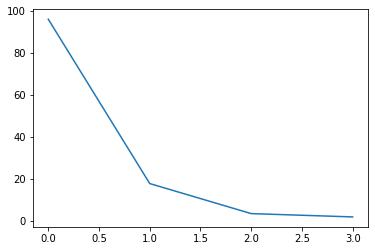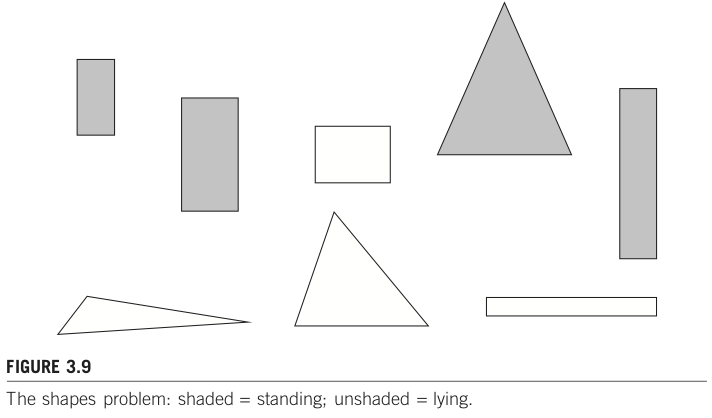SVDによる次元削減の例¶
全体の流れ
iris datasetを準備。
SVDで特異値分解し、3次元に圧縮。
比較対象としてPCAで第3主成分まで使うものを用意。
LogisticRegressionで分類学習。学習・テスト用のデータセット分割は省略。
import numpy as np
import matplotlib.pyplot as plt
from mpl_toolkits.mplot3d import Axes3D
from sklearn import datasets
from sklearn import linear_model
from sklearn import decomposition
データセット準備¶
iris = datasets.load_iris()
X = iris.data
y = iris.target
print(X.shape)
print(X[0])
print(len(y))
print(y)
(150, 4)
[5.1 3.5 1.4 0.2]
150
[0 0 0 0 0 0 0 0 0 0 0 0 0 0 0 0 0 0 0 0 0 0 0 0 0 0 0 0 0 0 0 0 0 0 0 0 0
0 0 0 0 0 0 0 0 0 0 0 0 0 1 1 1 1 1 1 1 1 1 1 1 1 1 1 1 1 1 1 1 1 1 1 1 1
1 1 1 1 1 1 1 1 1 1 1 1 1 1 1 1 1 1 1 1 1 1 1 1 1 1 2 2 2 2 2 2 2 2 2 2 2
2 2 2 2 2 2 2 2 2 2 2 2 2 2 2 2 2 2 2 2 2 2 2 2 2 2 2 2 2 2 2 2 2 2 2 2 2
2 2]
SVDによる特異値分解¶
U, s, Vt = np.linalg.svd(X)
print(U.shape, s.shape, Vt.shape)
(150, 150) (4,) (4, 4)
print(U[0])
[-0.06161685 0.12961144 0.0021386 0.00163819 -0.07300798 -0.08134924
-0.06909558 -0.07113949 -0.06195164 -0.06612256 -0.0779418 -0.06706386
-0.06552289 -0.06185789 -0.08830269 -0.08976151 -0.08609401 -0.07666031
-0.08279348 -0.07649756 -0.07454597 -0.07870518 -0.07197388 -0.07751697
-0.06350528 -0.06858871 -0.07505083 -0.07437007 -0.07521512 -0.06493685
-0.06604042 -0.08201589 -0.07386819 -0.08227844 -0.06867133 -0.07401577
-0.08107661 -0.06901449 -0.06347898 -0.07258421 -0.07640179 -0.06508444
-0.06416128 -0.08048951 -0.07430155 -0.07062043 -0.0727626 -0.06586452
-0.07649708 -0.07198453 -0.09197854 -0.08823139 -0.09036906 -0.07299205
-0.08712533 -0.07165625 -0.0873042 -0.06532195 -0.08381366 -0.07375745
-0.06302969 -0.08388409 -0.07222819 -0.07795265 -0.08122842 -0.09086183
-0.07599136 -0.0698583 -0.08193049 -0.07120772 -0.08509553 -0.08336609
-0.07965387 -0.07251397 -0.08448281 -0.08907596 -0.08653833 -0.09104982
-0.08142908 -0.07518959 -0.07060805 -0.06924548 -0.07732822 -0.0761784
-0.07310193 -0.08568359 -0.08985201 -0.07980502 -0.0756386 -0.07367435
-0.06672195 -0.07947999 -0.07580088 -0.06642552 -0.07342897 -0.07334836
-0.07555598 -0.08159337 -0.07465988 -0.07640103 -0.09482259 -0.08093526
-0.09634801 -0.08036141 -0.09141467 -0.09526824 -0.06927014 -0.08650523
-0.0824033 -0.10766229 -0.09530278 -0.08723118 -0.09675863 -0.08254321
-0.09402024 -0.09913198 -0.08477818 -0.10080471 -0.09688732 -0.07311009
-0.10161079 -0.08330813 -0.09229571 -0.08798247 -0.09396497 -0.08964253
-0.08806509 -0.08611647 -0.08911128 -0.08623509 -0.09252995 -0.10215519
-0.09166004 -0.07830493 -0.06625347 -0.10774146 -0.09735974 -0.08367461
-0.08585795 -0.09973069 -0.10211517 -0.1083868 -0.08093526 -0.09779369
-0.10416003 -0.10397003 -0.08866275 -0.09343429 -0.09573864 -0.08085465]
print(s)
[95.95991387 17.76103366 3.46093093 1.88482631]
# 対角行列に変換
sigma = np.zeros((U.shape[1], Vt.shape[0]))
for i in range(Vt.shape[0]):
sigma[i, i] = s[i]
# 特異値分解によりどのぐらい近似できているかを確認
approximation = np.dot(np.dot(U, sigma), Vt)
diff = X - approximation
print(np.linalg.norm(diff))
4.409066883547835e-14
# 特異値分解によりどのぐらい近似できているかを確認
np.allclose(X, approximation)
True
# 特異値の大きさを確認
plt.plot(s)
[<matplotlib.lines.Line2D at 0x7f8c1fa0f490>]

行列Uのk=3までを採用(=次元削減)¶
k = 3
new_x = U[:, :k]
print(new_x.shape)
print(new_x[0])
print(X[0])
(150, 3)
[-0.06161685 0.12961144 0.0021386 ]
[5.1 3.5 1.4 0.2]
比較対象用の主成分分析による次元削減¶
pca = decomposition.PCA(n_components=3)
pca.fit(X)
new_x2 = pca.transform(X)
print(new_x2.shape)
print(new_x2[0])
(150, 3)
[-2.68412563 0.31939725 -0.02791483]
分類学習の結果¶
scores = []
dataset = {"original":X, "SVD(k=3)":new_x, "PCA(n=3)":new_x2}
for label, data in dataset.items():
clf = linear_model.LogisticRegression(penalty='l1', solver='liblinear',
tol=1e-6, max_iter=int(1e6),
warm_start=True,
intercept_scaling=10000.)
clf.fit(data, y)
scores.append({label:clf.score(data, y)})
print(scores)
[{'original': 0.9533333333333334}, {'SVD(k=3)': 0.8733333333333333}, {'PCA(n=3)': 0.9666666666666667}]
